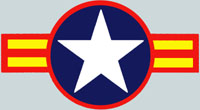 Credit: Roundels of the world
Credit: Roundels of the worldRepublic of Vietnam roundel on aircrafts
Last update 26-04-2022
 Credit: Roundels of the world
Credit: Roundels of the world
Republic of Vietnam roundel on aircrafts
Last update 26-04-2022
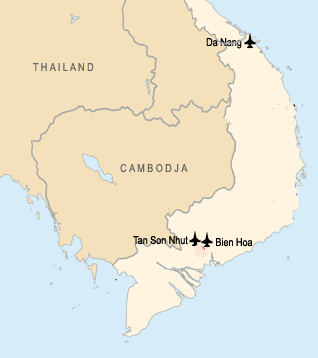
THE HISTORY OF THE NORTHROP F-5 USED IN THE REPUBLIC OF SOUTH VIETNAM
IS COMPLICATED DUE THE LOSS OF DOCUMENTS ON CAPITULATION.
ONLY KNOWN IMPORTANT DATAS ARE SHOWN HERE.
Beginning of the Northrop F-5 era
The introduction of the Northrop jet-fighter, in its single- and double-seats configuration,
was initially questioned at a Honolulu meeting (06-05-63) by the US
Secretary
of Defence Robert McNamara and military US advisers. The Republic of
Vietnam representative had originally requested the supply of McDonal F-4
Phantoms, while
the
US military requested 25 of the Northrop fighters. R.
MacNamara postponed a decision to supply South Vietnam till the planes
could be tested in combat by USAF.
Secretary
of State McNamara was won to alowing Vietnam AF Northrop F-5s on the
grounds that the jet had proved themselves to be a good close air support
vehicle,
that they posed no threat to Nort Vietnam and therefore did
not signal escalation; they would provide to defend the country against
air attacks when the USAF finally
withdrew.
The Northrop F-5 saw combat in three major offensives: in 1968, 1972 and 1975. There were several changes of mind on US side regarding the structure of South
Vietna mese jet aircrafts, listed below.
Local US Military Assistance Air Group (MAAG) planned the use of the Northrop light fighter starting in Fiscal Year 1964
when it was foreseen to
establish during FY 1966
two Vietnamese Squadrons of Northrop N-156
(F-5A); the first replacing North American T-28s and the other
Douglas A-1H attack aircrafts, this to be sometime
between 1966 and 1968.
The US/Military AF
Advisory Group changed his mind and decided on 06-07-66 that 6 Vietnamese Squadrons equipped
with Douglas A-1 should be converted: 2 on Northrop F-5A and 4 on Cessna A-37 aircrafts. A
dramatic change took place again already in November 1966 when the
command approved only 1 Northrop F-5A unit (with an establishment of 18 aircrafts) plus 3 Cessna A-37A and 2
Douglas A-1H Squadrons (all
of them with 18 aircrafts). The Squadrons were reduced in size from the original planned estabishment of 25
.
By
late 1965, the American advisors
were turning from expanding to modernizing the Vietnamese air arm.
Plans were taking shape in December for modernization over the next
three years. Two of the six fighter
squadrons would gradually convert
to F-5s (if McNamara could be persuaded), the H-34 helicopters would
give way to newer UH-ls, and at least one of the 2 C-47 squadrons would receive C-119 transports. Major
improvements were envisioned for the forward air controller program,
the air defense net, and in the realm of communications, which was
particularly weak.
Definitive authorisation
was given by the Department of Defence to transfer former USAF " Skoshi Tiger" program Northrop
F-5A/C and F-5B in order to equip one Squadron under the Military Assistance Program,
planned in March 1967 but postponed for a short time.
The 522nd Squadron of the
23rd Wing based at Bien Hoa AFB stood down in September 1966 while the
first batch of 32 Vietnamese pilots (only 1 failed) transiting from Doulas A-1 to
Northrop F-5 (via Northrop
T-38A) was sent to USA, Williams AFB in October 1966 till April 1967 for
training; grond crew was trained in Vietnam and sent to Clark AFB (Philippines). The initial 17 Northrop F-5A/C and 2 F-5B, originally belonging
to
the 3rd
USAF Wing, were unofficially transferred to the Republic of
Vietnam on at Bien Hoa AFB 17-04-67 and officially on 01-06-67
at Tan Son Nhut AFB where
27 pilots arrived combat-ready and 160 airman and
officers were trained to maintain the new fighter; the ground crew obtained the
help of 75 men jet mechanics for the initial months. Air-to-air refuelling system was removed in order not to allow operations over
North Vietnam (an unofficial statement).
Planned
utilisation was 35 hours per month, with a desired in service rate of
75 percent. These figures were only achieved next year. By December 1969 rate
was 34 hours utilization per aircraft/month; 34 weather
aborts had
lowered this rate. In-commission rate was 85.2 %; the 522nd Sqn did
well in combat and most close-support missions could be completed.
Two losses were exclusively on ground attacks.
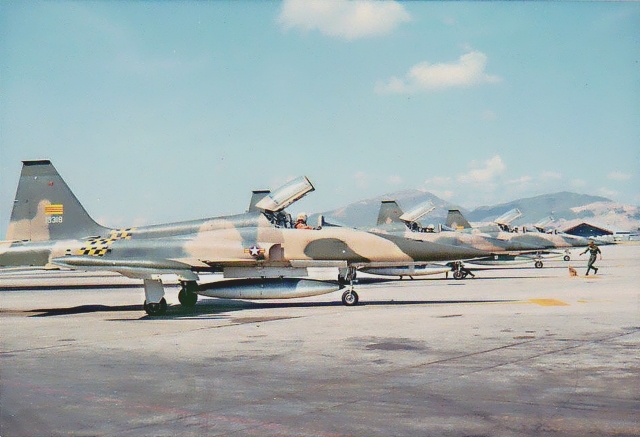 Photo: manhainote
Photo: manhainote
Northrop F-5A 13318 of the 522nd Figher Sqn with three companions at Da
Nang AFB 1968.
Of note different camouflage on each aircraft.
Military
Assistance Program povided by the end of 1967 fifteen Northrop
F-5, by 1968 a total of twenty aircrafts; these remained property of the USA not
to be transferred to foreign countries without US approval.
One Squadron of the 92nd Support Wing at Pleiku was scheduled for
conversion from Douglas A-1 to Northrop F-5 aircrafts in April
1967, three others to Cessna A-37 in FY 1969.
During
the "Tet offensive", started 30-01-68 and lasting till 25-02-68, Northrop F-5A
losses were also on ground; six aircrafts
at Bien Hoa AFB were damaged by two rockets and mortar attacks.
Seventeen were
available duringt that moment at Bien Hoa AFB.
May 1968 saw the invasion of Cambodia, support was given by Douglas A-1s and Northrop F-5s. By the end of FY 1968 18 Northrop F-5s were on strength.
Due to improviment of relationship Cambodia sent in 1970 one Mig-15 und one MiG-17 to Vietnam as an friendly visit; they were met by 8 Northrop F-5A and accompanied to Bien Hoa AFB.
Vietnamisation
Initial
Vietnamisation planning (through the use of local personnell) began in 1968, starting in July 1969 with the begin of US troops withdrawal. It
was called "Improvement and Modernization Plan". Plans for
enlarging
and modernizing the Republic of Vietnam were arranged
to the maximum extent in order to have the burden of war gradually
shifted to Vietnam. The USA proposed structure included two Squadrons
of Northrop F-5
for air defence to be obtained in five years.
By 1968 pilots for Northrop F-5s were still trained in the USA;
the US study on the Vietnamese Air Defence System required 3 Northrop
F-5 Squadrons. There were initially
to be 1 existing unit plus 1
converting for Douglas A-1. USAF
Mobile Training teams taught Northrop F-5 and Fairchild C-119
maintenance inside Vietnam, together with logistic management and the
English language.
By 30-09-69 accoding an USA source 23 Northrop F-5A (5 lost), 2 Northrop RF-5A had been delivered
Supply
of new fighter was limited as the Northrop F-5 was foreseen for foreign
sales only and the aircraft production base was weak: items lead times
were a limitng factor. Only 25 Northrop F-5s for MAP were built
each
month.
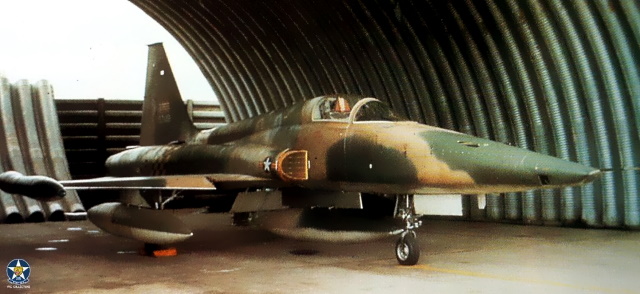 Photo: unknown
Photo: unknown
Beginning of the year 1970 saw also the delivery of 6 Northrop RF-5A to give an high-speed reconnaissance capability, one seen here.
Depot level maintenance training started only
in 1969;
it was practically non-existant earlier.
Major repair, overhaul and rebuild were
routinely accomplished by the USAF maintenance programm. General
Electric J-85
were maintained at the Bien Hoa AFB depot. By late 1969
the Air Force had learned to maintain the Freedom Fighter armament
system. USAF supply and maintenace specialists were still at hand.
By 01-01-70 authorised strength for the 522nd Fighter Squadron was 20 aircrafts, 17 possessed, 15 were combat ready with 26 crews.
The 3rd Air Division
was activated on 01-05-70 with Headquarters at Bien Hoa AB including
the 23rd Tactical Wing / 522nd Fighter Squadron with 16 aircrafts (13 combat ready, 28 crew). Its resposability was to
defend Saigon and its neighborhoud from Viet Cong and North Vietnamese troops.
Fast
jet reconnaissance capability was added in July 1970 when the first 2 of 6 Northrop
RF-5A were delivered (each 2) in the fourth part of FY 1970, as well as in the 3rd and in 4th part of FY 1971 plus three attrition
replacements programmed in FY 1972. Personnel completed training given by two Mobile Training Team on
15-10-70. It became operational
on 01-11-70 (four months ahead of plans) after training and tactics deve-
lopment.
This was limited to Visual Flight
Rules missions because no infrared, photo flash or Side-Looking Radar
(SLR) was available. Reconnaissance aircraft flew from/landed at Bien Hoa AF where the films were carried to Tan
Son Nhut airfield and
interpreted by the Photo Exploitation Center. A study considered
landing of reconnaissance aircrafts at Tan Son Nhut directly; only ten
percent of the reconnaissance needs were flown by the
Republic of Vietnam AF.
A new North Vietnamese offensive started in February 1971, when a deliberate disengagement of US ground forces and the "Vietnamization" started.
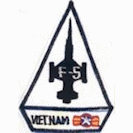
Attack Squadrons were by January 01, 1972: one Northrop F-5A with 18 aircrafts (authorised/activated/operationnally ready), one composite reconnaissane Sqn with 28 aircrafts, of 19 were opera-
tional C-47; two Northrop F-5A Squadrons (authorised only, included in operation "Enhance Plus") plus six authorised Northrop F-5A units in a future force structure not dated; one Reconnaissance
composite unit with Douglas C-47, de Havilland U-6 and Northrop RF-5A. Air
Defence units were authorised: 3 on Northrop F-5E with 54 (also mentioned 57) aircrafts were (none active, activation foreseen in FY 1975),
no additional foreseen in a future force structure. Definitive authorization
to provide air defence suited Northrop F-5E was given in December 1972, to be procured in FY 1973.
Air
Combat Maneuvers as well as Air Defence training with Northrop F-5As started in
January, lasting from January till March 1972, following insistence of the US Advisory Group.
This consisted in
air-to-air firings against Dart systems and in AIM-9
Sidewider missile operation training, though the aircrafts were of
limited deterrent to the opponent Mikoyan-Gurewich MiG-19 and MiG-21.
No
night Northrop F-5 flying was operated in the air-defence
missions. The only anti-aircraft availability were two anti-aircraft battalions and 6 Nothrop F-5A at Da Nang AFB.
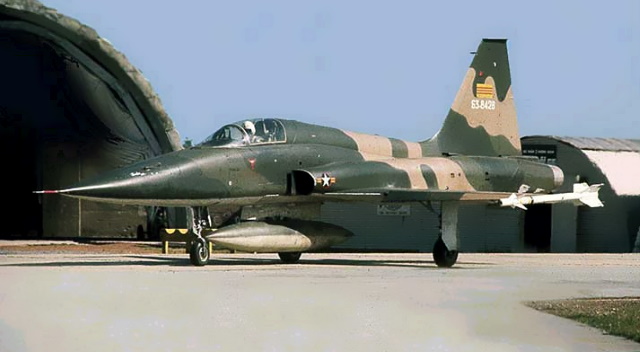 Photo: unknown
Photo: unknown
AIM-9B Sidewinder armed aircraft
at Da Nang AFB
On
30-12-71 the US Government was authorised to procure 54 Northrop F-5E
for 3 Squadrons in FY 1973 in Vietnam, only half of these
originally
planned to purchase untill FY 1974. Planned was also the delivery of 5
additional Northrop F-5A.
A first peace agreement was announced on 25-01-72
by US President R. Nixon. North Vietnamese "Thet offensive" was launched
on 30-03-72 (Easter Offensive) though there had been a peace agreement.
The offen-
sive could be stopped.
The North Vietnamese armed forces had improved in the meantime their
anti-aircraft artillery and was equipped with SA-2, SA-7 ground-to-air missiles at the beginning of the offensive. Northrop F-5As and
Cessna
A-37s had therefore to adopt tactics that limited their
effectiveness, like releasing bombs at higher altitude, diminishing
precision and placing new limits to the support they could provide.
Anyhow the Air Force flew by 31-02-72 with 90 Douglas A-1s and Northrop F-5As some
2'500 of which 2'200 were close support or interdiction mission, 300
flack suppression; operational sorties decreased in May 1972
to 185 missions showing the improved situation.
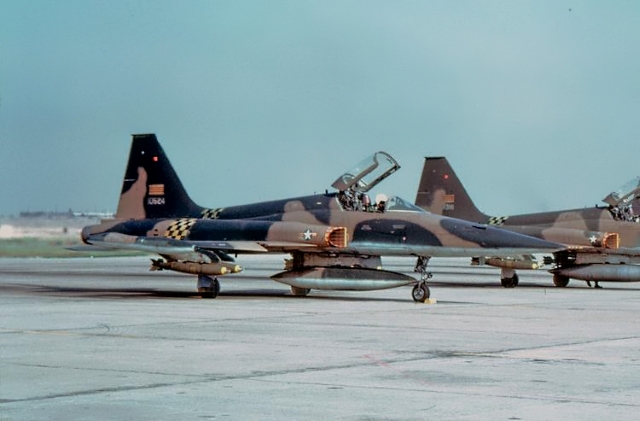
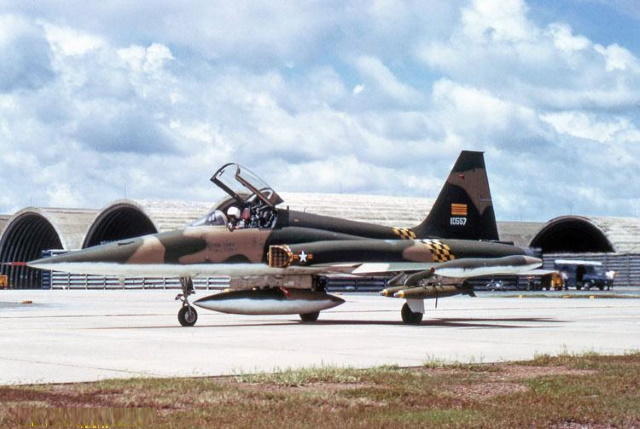
Four 250 lbs armed Northrop F-5A 10524 seen early
70s with camouflaged underfuselage tank; Another Northrop F-5A (serial 10577) with four 250 lbs bombs at Tan Son Nhut base in 1972
note
different camouflage and silver underwing tank on
aircraft next to
it.
seen
from a different side.
Photo:Archive the Northrop F-5 enthusiast
On
30-12-71 the US Secretary of Defence had authorised additional
procurement in Fiscal Year 1973 of 57 Northrop F-5E for Vietnam, in
order to improve capability for interdiction in a high threat
environment as well
as increasing air defence in the face of MiG
activity which had also reconnaissace missions over the Northern part
of South Vietnam. Originally just half of the Tigers were foreseen in
Fiscal Year 1974.
By 31-03-72 accoding an USA source 29 Northrop F-5A (2 lost), 2 Northrop F-5B, 6 Northrop RF-5A (1 lost) had been delivered.
A pair
of Northrop F-5A chased on 09-10-72 two Iliushin IL-28 bombers returning
from action in Bam Luang (Laos), near the South Vietnamese border. They
retired when MiG-21 approached. This was one of the few
air-to-air
action of the Freedom Fighter in Vietnam.
In June 1972 an USA working group suggested the delivery of 2 Northrop F-5E Squadrons, with no organizational changes to the existing Air Force beyond those associated with this equipment.
A
USA study showed on 11-10-72 that the Air Force was unable to operate
immediately new aircrafts (additional F-5s, or Douglas A-4, or Ling-Temco-Vought
A-7 or McDonnell F-4 replacing Douglas A-1) due to
personnell and
maintenance problems. The most feasable plan was to enhance capabilities
over the next five years replacing 12
Squadrons of Douglas A-1 attack force with an additional Northrop F-5E and 8 Cessna
A-37 units.
A rocket attack against Bien Hoa AB by the Viet Cong guerilla destroyed 3 silver painted Northrop F-5on 06-11-73.
Hoang Sa Operation
The Operation Tran Hung Dao 48
(battle for the Hoang Sa/Paracels Islands, ca 400 miles from Bien Hos
AFB) took place starting 19-01-1974, openly challenging the People'
Republic of China the People' Republic of
China Army/Navy. The islands were considered as belonging to Vietnam (South and Nord). A detachment of the Army and several ships were sent to clarify the situation and expell the Chinese, but was repelled after
a furiuos naval battle.
Chinese Mikoyan-Gurevitch MiG-21 were stationed on Hainan Island but
believed to be too short on range, a flight of Tupolec Tu-16 Badgers was transferred to Hainan. South Vietnamese Air Force
Cessna A-37s and
Douglas A-1s were too slow due to the danger provided
by Chinese anti-aicraft units. Northrop F-5As, RF-5A were sufficent fast to participate to the fight, while Northrop
RF-5A provided reconnaissance, though
both these aircraft had a limited endurance to stay on the islands, pilots
had little experience flying over the sea and in air-to-air combat.
Five Squadrons of Northrop F-5s were available, four at Ben Hoa AFB (536th, 540th, 542, 544 Squadrons) one at Da Nang AFB (538th Squadron); almost all aircrafts from three Bien Hoa Squadrons were transferred
to Da Nang AFB, nearer to the objective.
The reconnaisance Northrop RF-5A photographed the area and the
ennemy's ships. The first aim was to destroy the Chinese fleet
using
guns, rockets and bombs; each Squadron was assigned an area where to
sink
the ships (ca 40, small and medium). Unfortunately a naval battle was unsuccesful for Vietnam and the plan didn't
succed; Vietnamese force had to retreate.
Program Enhance Plus
"Operation Enhance" was almost completed when the US governement informed on 20-10-72 that they had directed
delivery of additional equipment: project "Operation Enhance Plus".
A telegramm sent on 19-10-72
to
H. Kissinger confirmed that 47 Northrop
F-5A (to be former Iranian, Chinese, Korean AF aircrafts) could be
supplied within 14 day from the receipt of order. The
project was to rush equipment before the deadline
(initially to be 10-11-72, changed to 30-11-72 and finally to 01-02-73) of a second (final) peace
agreement
reached between USA and North Vietnam in Paris, signed on 27-01-73. This lead to retirement
of US forces
and official legitimation of Northern Vietnam occupied teritories during the Eastern Offensive in 1972.
On
20-10-72 the US Secretary of Defence announced the US President's
decision to deliver additional equipment not later than 01-11-72 to the
Republic of Vietnam, without consulting his military advisers. By
October
1972 the US Secretary of Defence obtained the reduction of
Freedom Fighters to 116 (possibly no Northrop RF-5A), 5 additional
Northrop F-5A were planned to be delivered later; activation of two additional
Northrop
F-5As units was foreseen.
Several additional aircrafts inoundated South Vietnam, including
116 Northrop F-5As that were from South Korea (36 F-5A and 8 RF-5A), Iran (32 F-5A in two lots of 16 each), Taiwan (48 F-5A). These were hurriedly
withdrawn from use of the countries' air forces and forwarded to Bien Hoa AFB aboard USAF Lockheed C-5 and Lockheed C-141 transport aircrafts, where they were re-assembled.
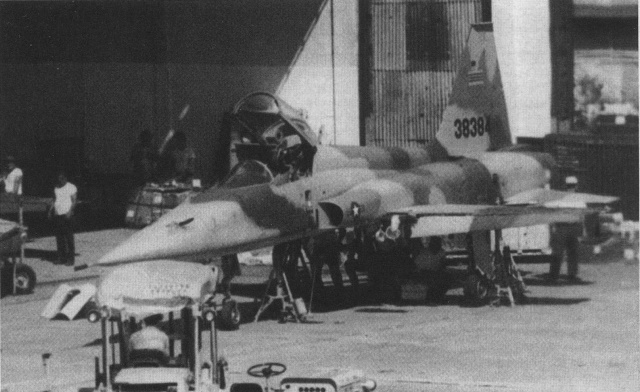 Photos: USAF
Photos: USAF 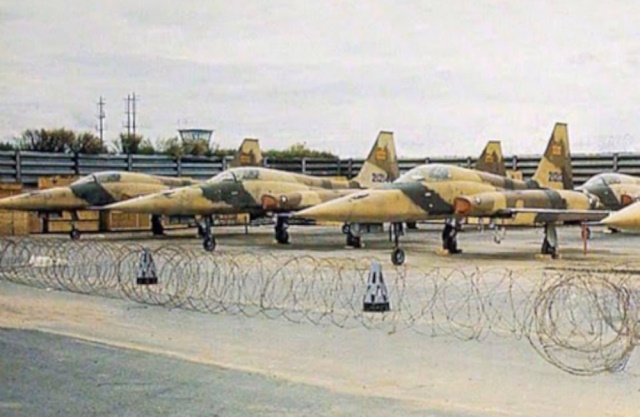
Former Iranian Northrop F-5A 38384 being reassembled shortly after delivery
Colour view of stored, former Iranian aircrafts
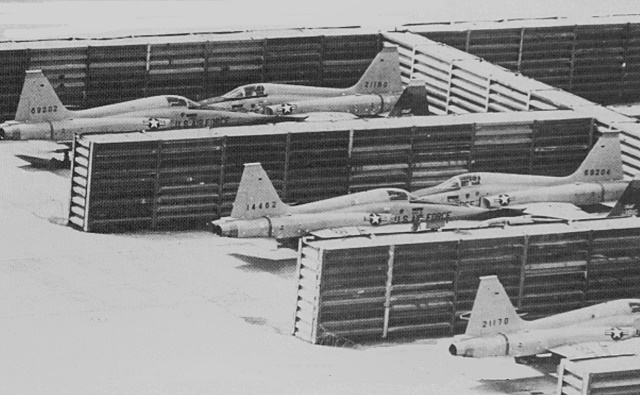
Former R. China AF, non camouflaged, Northrop F-5A still in USAF markings awaiting to be
integrated in the S. Vietnamese AF
According
to official US sources the Military Assistance program provided during the fourth
quarter of:
FY 1971 27 Northrop F-5A, FY 1972
11 Northrop F-5A, while FY 1973 saw the delivery of 116 Northrop F-5A.
The Freedom Fighters were followed during the fourth
quarter of: FY 1971 by 6
Northrop RF-5A for reconnaisance and 3 RF-5A during FY 1972.
Training Northrop F-5B were also supplied: 4 during FY 1971; seven additional were planned by FY 1975.
This
put an extreme strain to the operation and maintenance of the Air
Force. Pilots of Cessna A-37 were re-trained on the Northrop F-5; others
were also re-trained from Douglas A-1s to superior performance aircrafts.
A shortage of 800
pilots/co-pilots, particulary for transports and helicopters, was assessed two
weeks after the 27-01-73 signature of the Paris cease fire agreement; by February 1973 American
civil contractors
personnel repaired electronic devices and engines General Electric J-85 that powered the Northrop F-5s and Cessna A-37s.
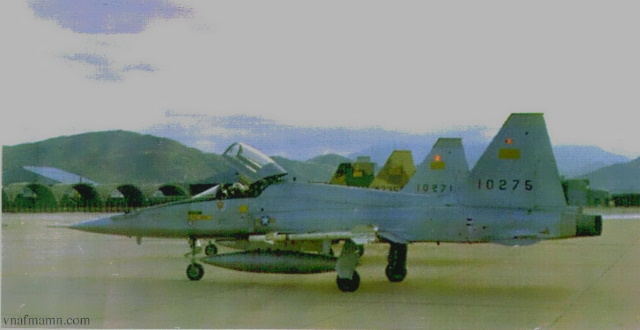 Photo: vnafnmn.com
Photo: vnafnmn.com
The variety of original countries/colours of Northrop
F-5As received are clearly shown here
Rocket
attacks against air bases resulted in casualties: on 06-11-73 three
(four according some sources) Northrop F-5A were destroyed at Bien Hoa
AFB.
With the 28-01-73 US/North Vietnam
Paris peace agreement the USA started their "Operation Homecome", withdrawing all their fighting forces from the country; the agreement was interpreted by the USA as allowing
replacement of
aircrafts (in this case Northrop F-5A) returned to the country of origin
(South Korea, Taiwan) by new Northrop F-5E aircrafts.
On 29-03-73 the last US fighting troops left the Republic of Vietnam,
leaving South Vietnam to fight alone. Additional North Vietnamese
troops were infiltrated in the South, together with deadly 23 and
37mm and
SAM anti-aircraft guns/missiles. The Republic of Vietnam AF was unable to attack these as it lacked Electronic Counter Measures equipment, being powerless to stop the build-up.
As the USA had agreed to return 20 single-seaters to the Republic of China and 36 to S Korea, USAF
personnel recommended mid-1973 the withdrawal of 47 Northrop F-5A,
stored at Bien Hoa AF by August 1973.
Vietnam was unable to repair
heavy corrosion damage on the aircrafts; only 18 were flyable. Nine
Northrop in use at Williams AFB, 425th Squadron, could also be sent to
Asia to make up the difference in numbers and
meet the commitment in
full.
Tiger introduction
The Enhance Plus plans foresaw also the early activation of three Northrop F-5E units, transferring experienced Cessna A-37 pilots to them.
Between July and October 1973 320 personnel went to the USA in order to
support the introduction of the Tiger, particularely into the weapons
system inventory;
eight were trained as pilot-instructors. They returned
to Vietnam in
December 1973 to start the new programm for
partial improvement of the situation. Twenty-two additional were
training in USA and eight were to start their training in March 1994. A total of 38 qualified
Freedom Fighter instructor-pilots
were foreseen to update to the Tiger in USA and return to Vietnam to
conduct transition training while the US trained mainternace crew was
in charge of local personnell at Bien Hoa AB.
Earlier Northrop F-5A were returned to USA, via Clark AFB Philippines in exchange for the new Tigers; two are shown hereunder.
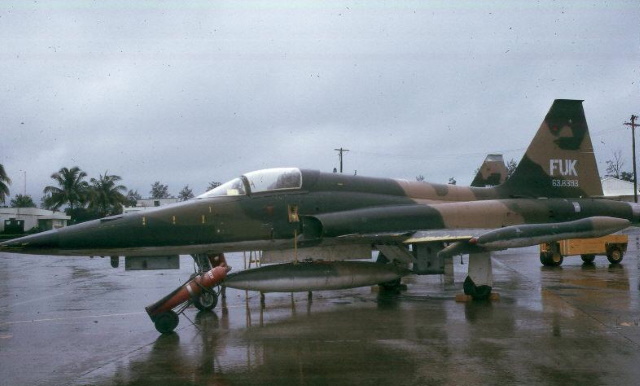
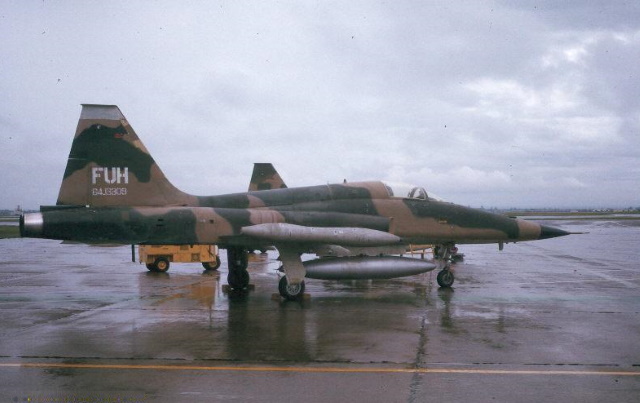
Northrop F-5A 63.8383 coded FUK
at Clark AFB in August 1974
Also seen at Clark AFB in August 1975 serial 64.1330, code FUH
The frst (F) and last code (K or H) are the aircraft identifier, while
middle code U denotes the Squadron, (which one?)
Photos: collection The Northrop F-5 Enthusiast
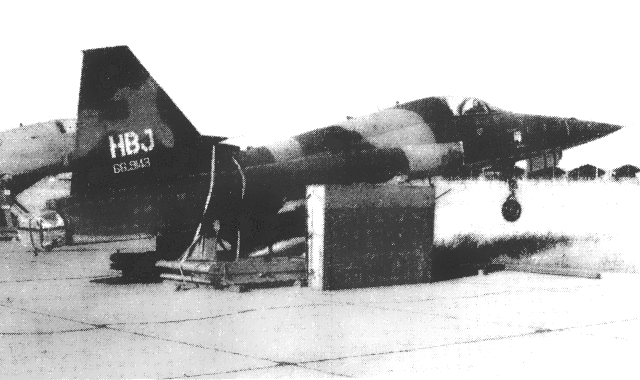 Photo: "FLIGHT LINE"
Photo: "FLIGHT LINE"
Pilots in South Vietnam had to release their bombs and rocket at a higher
at a higher altitude to avoid the anti-aircrafts guns and the (in the
meantime) poured in from North Vietnam radar equipped guns and ground-
to-air SA-7 Strela missiles, lowering their precision and
rendering ground support much more difficult.
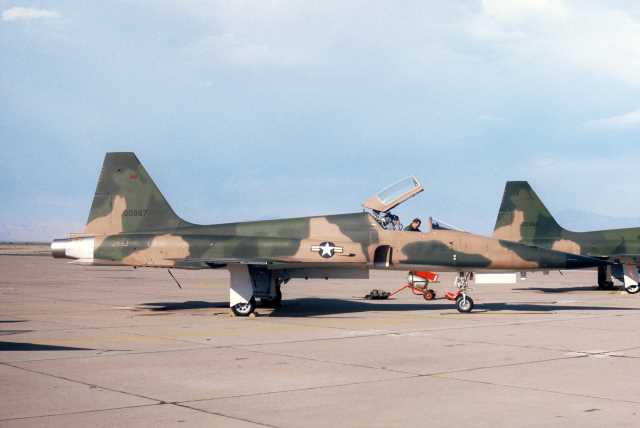 Photo: collection The Northrop F-5 Enthusiast
Photo: collection The Northrop F-5 EnthusiastUSA Department's of Defence Military Assistance Program request included in FY 1974 refund payment of 69,3 millions for 116 F-5A already transferred to the Vietnamese AF from foreign MAP countries. New
procurement included 71 Northrop F-5E.
Planned Department of Defence Northrop F-5E mentioned during a hearing in the US Congress in March 1974 was 25 aircrafts (value USD 53.7 millions), in FY 1974 and 43, valued USD 92.3 millions, during FY 1975,
subjet to poduction and to dollar value.
Slightly different is the numer of the advanced version Northrop F-5E
Tiger supplied/planned as follows: 28 by 1974/fourth quarter and 50 by 1975/fourth quarter which
probably is the exact figure.
Actually delivered to South Vietnam before the fall of Saigon (30-04-75) were some
153 Northrop F-5A, RF-5A, F-5B but combat losses, lack of sufficent spare parts,
sometimes also shortage of qualified maintenance
personnel dastically reduced
the combat readiness of these fighters. Some of the recently delivered Northrop F-5A were by April
1975 still in storage.
In
terms of training and logistics, the decision to replace some Freedom
Fighters with later Northrop F-5E was a mistake as a different fighter
took the place of familiar one, training and logistics already
overstretched by
the old and new aircrafts and helicopters supplied.
Fighter-bomber Cessna A-37 and Northrop F-5 could not carry the same
amount of bombs as the Douglas A-1, though they had more survival
chances to anti-aircraft
guns because of their speed.
Capitulation
At
the begining of 1975 up to half of the aircrafts from each unit as
grounded due to a severe spare shortage, each non-operational fighter
providing spare to the operational ones. Beginning
1975 4 Northrop RF-5A
on reconnaissance missions were shot down; in any
case their photographic results were also considered not clear enough
to be interpreted.
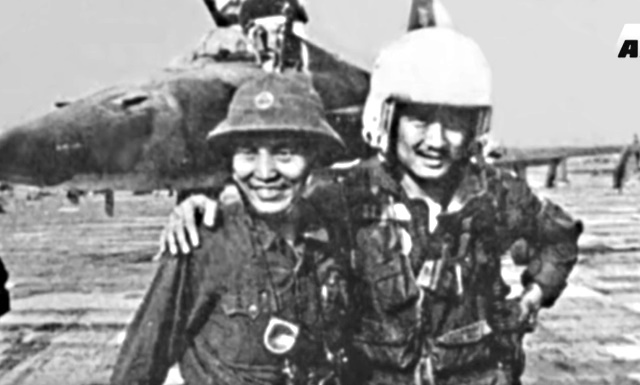
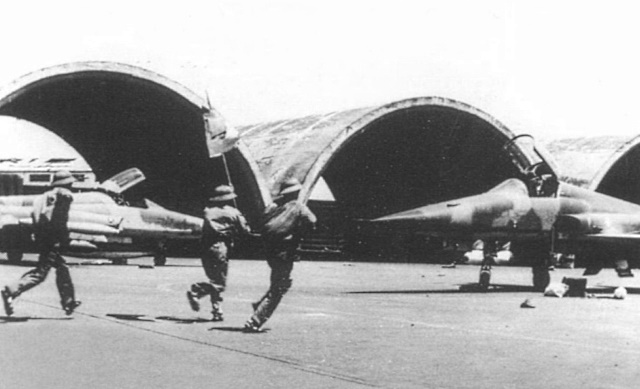
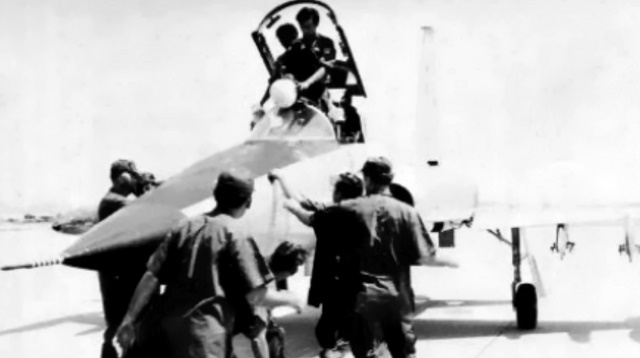
Losses/Abandoned/Transferred aircrafts on capitulation
Various fonts report differen number for different periods, it is very difficult (if not imposible) to have an exact overview of actual numbers.
Reported are 3 Northrop F-5s lost at Tan Son Nhut (Saigon) due
to bombing on 28-04-75, while 3 Northrop F-5A, 1 RF-5A, 1 F-5B and 27 F-5E were abandoned at Bien Hoa AFB by the end of April 1975. One
Northrop F-5B crashed trying to land on an highway to the East of U-Tapao AB, due to fuel shortage.
In the morning of April 29th twenty-seven Northrop F-5s escaped to U-Tapao AFB (Thailand): 3 Northrop F-5As, 1 Northrop F-5B (later transferred to Thailand), 1 RF-5A (to South
Korea) and 22 Northrop F-5E (sent
back to USA) together with a
variety of other aircrafts both formerly belonging to the Repulic
of Vietnam and to Cambodia.
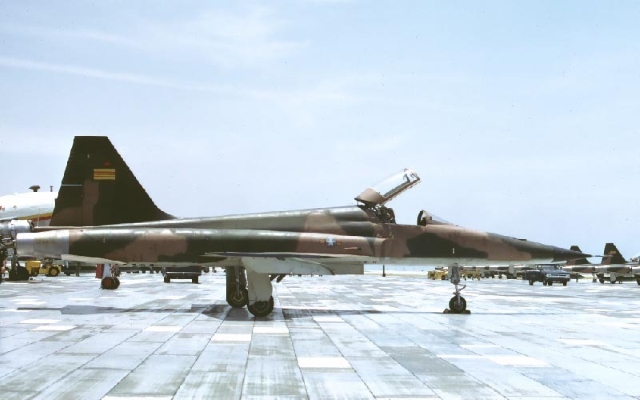 Photo: unknown
Photo: unknown 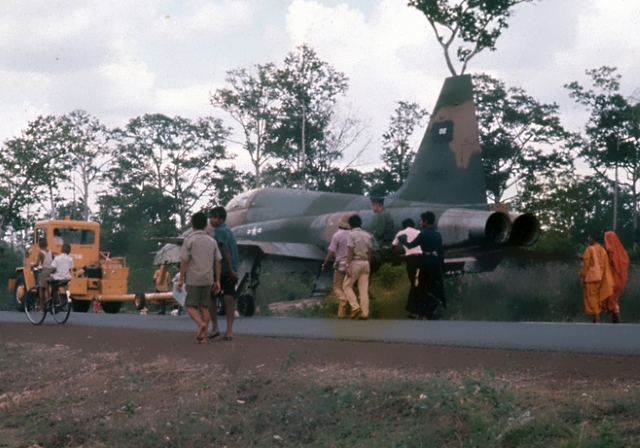
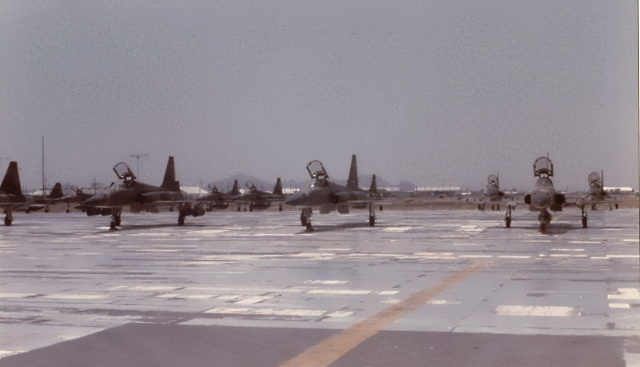
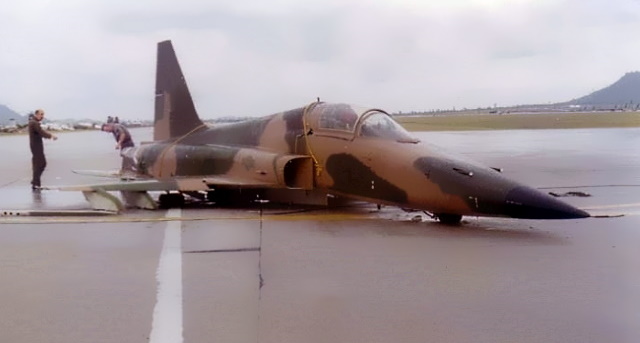
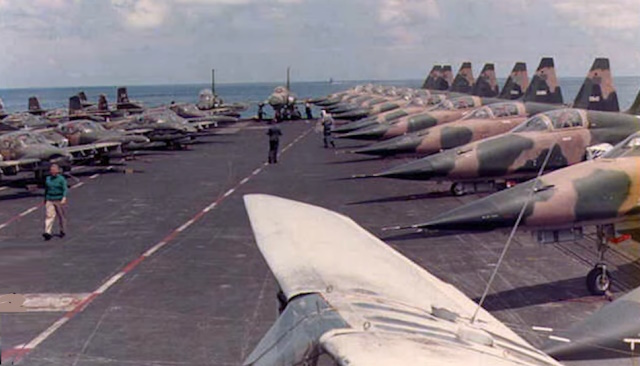 Photo: US Navy
Photo: US Navy